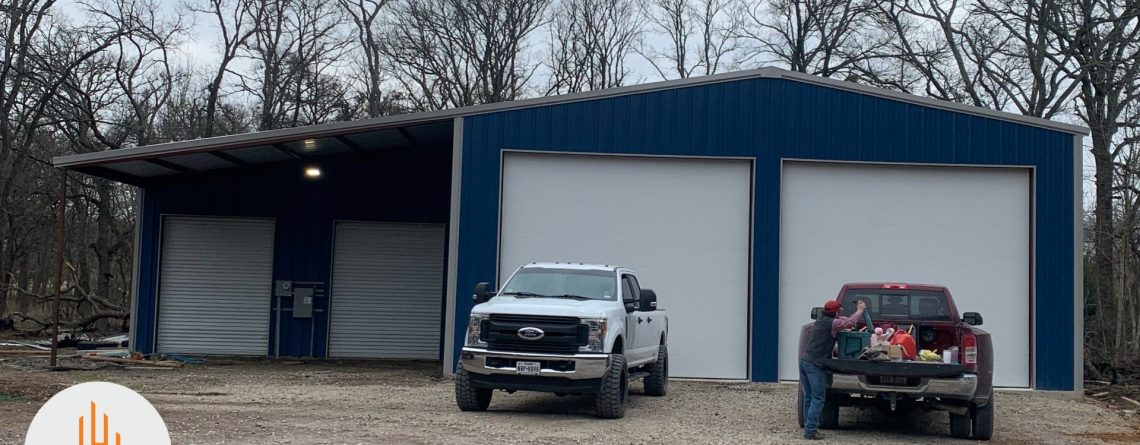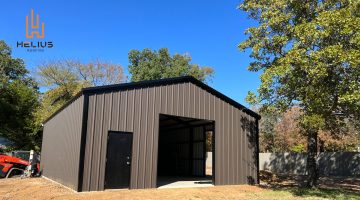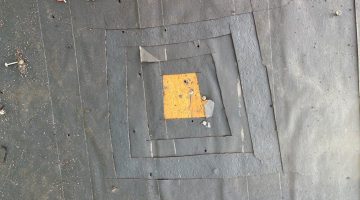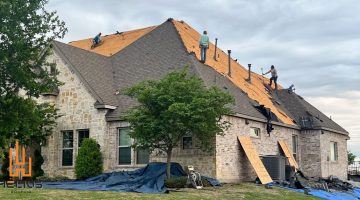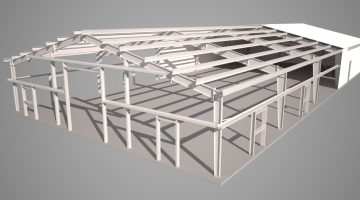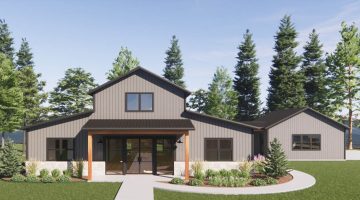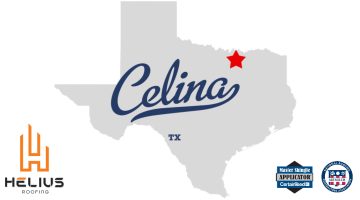By Helius Roofing & Construction
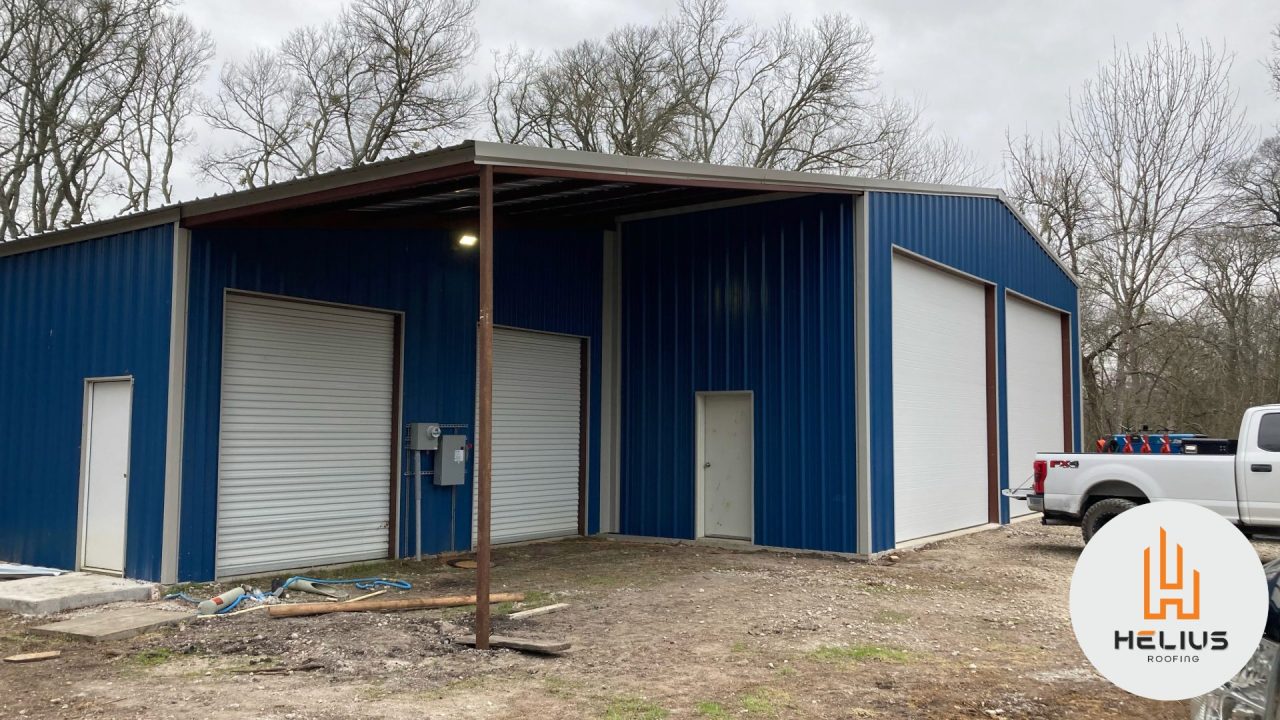
Metal buildings are gaining popularity in the construction industry due to their versatility, durability, and cost-effectiveness. Whether you are building a storage facility, garage, warehouse, agricultural structure, or even an office, metal buildings offer a flexible solution for various purposes. However, to ensure your metal building project meets your expectations and is a wise investment, there are several essential factors to consider during the planning and construction process.
At Helius Roofing & Construction, we’ve helped numerous clients design and build custom metal structures. This article will guide you through the key factors you should consider to ensure your metal building is functional, efficient, and built to last.
1. Building Purpose and Functionality
The first step in constructing a metal building is understanding the primary purpose of the structure. How you intend to use the building will significantly impact its design, layout, and features.
Determine Your Needs
Is your building meant for storage, a workshop, or as a commercial space? The function of the building dictates everything from the dimensions to the type of doors and insulation required. For example, a metal workshop may need extra ventilation and large windows for natural light, while a storage facility may focus more on security and weatherproofing.
Future Expansion
Another critical consideration is whether you anticipate needing more space in the future. Metal buildings are easily customizable and expandable, but planning for future growth now can save you money and time down the line. At Helius Roofing & Construction, we often recommend planning for additional space if your business or personal needs may grow in the coming years.
2. Location and Site Preparation
The location where you plan to build your metal structure will influence various design aspects. Choosing the right site and preparing it properly is essential to ensure the longevity and performance of the building.
Climate and Environmental Conditions
Different climates require different materials and structural designs. For instance, if your building is located in a region prone to heavy snowfall, you’ll need a steeper roof pitch to allow the snow to slide off easily. In areas with high winds, reinforced walls and additional anchoring may be necessary to provide structural stability.
In hot climates, reflective roof coatings can help reduce heat absorption, lowering cooling costs. On the other hand, in humid or coastal regions, corrosion-resistant materials such as galvanized steel or aluminum are essential to prevent rust.
Site Grading and Soil Quality
Proper site grading is crucial to ensure proper drainage and prevent water pooling around the foundation. The soil quality of your site will also influence the foundation type you choose. For instance, sandy or loose soil may require deeper foundations, while clay soils that expand and contract with moisture may need additional reinforcement to avoid structural damage.
3. Building Codes and Permits
Before you can break ground on your metal building, it’s important to comply with local building codes and secure the necessary permits. Each region has specific rules and regulations for construction projects, and adhering to them will help you avoid costly fines or delays.
Zoning Regulations
Local zoning laws dictate how land can be used and what types of structures can be built in certain areas. Before you begin construction, you’ll need to check whether the land is zoned for your intended use—whether that’s residential, commercial, or agricultural.
Building Permits
Once zoning approval is secured, you’ll need to apply for a building permit. Building permits ensure that your metal building complies with local safety standards, fire codes, and other structural regulations. Permits also cover electrical, plumbing, and HVAC systems if your building will include those features. It’s often best to work with a contractor like Helius Roofing & Construction who understands local codes to expedite the permit process and ensure compliance.
4. Design and Customization Options
One of the key advantages of metal buildings is their flexibility in design. With a range of customization options, you can tailor your building to fit your specific needs and aesthetic preferences.
Size and Layout
The size and layout of your building depend on its intended use. Metal buildings can be constructed in a wide variety of sizes, from small garages to expansive warehouses. The open-span design of metal buildings allows for wide, unobstructed spaces, making them ideal for large storage areas or workshops.
It’s important to consider not only the initial dimensions but also how the layout will support your operations. For example, a manufacturing facility may require an open floor plan for large machinery, while an office space will need separate rooms or partitions.
Roof Style
Different roof styles can offer both functional and aesthetic benefits. Some of the most common options include:
- Gable Roof: A classic roof style that slopes on two sides, allowing for easy water runoff and improved ventilation.
- Single-Slope Roof: A modern style that slopes in one direction, often used for smaller buildings or lean-tos.
- Gambrel Roof: A barn-style roof with two slopes on each side, providing additional storage or headroom.
Doors and Windows
Customizing the placement and type of doors and windows can improve both the functionality and appearance of your metal building. For instance, overhead doors are ideal for garages and workshops, while walk-in doors may be better suited for office or commercial buildings. Windows can provide natural light, improving energy efficiency and creating a more pleasant work environment.
5. Material Selection and Durability
The materials you choose for your metal building will determine its durability, longevity, and resistance to the elements. At Helius Roofing & Construction, we offer high-quality materials such as galvanized steel, which is highly resistant to rust, and aluminum, which is lightweight and corrosion-resistant.
Steel
Steel is the most common material used in metal buildings because of its strength, durability, and fire-resistant properties. Galvanized steel, which is coated with a layer of zinc to prevent rust, is especially popular in outdoor applications.
Aluminum
Aluminum is another excellent material for metal buildings. It’s lightweight, rust-resistant, and requires little maintenance, making it ideal for coastal or humid environments. Although not as strong as steel, aluminum offers flexibility in design and is suitable for smaller buildings or architectural elements.
6. Insulation and Energy Efficiency
Insulating your metal building is critical for maintaining a comfortable indoor environment and improving energy efficiency. Insulation helps regulate temperature, prevents condensation, and reduces noise.
Types of Insulation
There are several types of insulation to consider, including:
- Fiberglass Batts: An affordable and easy-to-install insulation option for metal buildings. Fiberglass batts provide good thermal resistance and soundproofing.
- Spray Foam Insulation: Offers excellent insulation by creating a continuous air seal, which helps prevent air leaks and condensation.
- Insulated Metal Panels (IMPs): IMPs combine insulation with the structural integrity of the metal panels, providing superior thermal performance and energy efficiency.
Reflective Roof Coating
For buildings in hot climates, a cool roof with a reflective coating can reduce heat absorption, lowering cooling costs and improving energy efficiency. Reflective coatings are particularly useful in areas with long, hot summers.
7. Foundation and Structural Integrity
The foundation of your metal building is one of the most critical elements of the construction process. A strong foundation ensures the stability and longevity of the structure.
Concrete Foundations
Most metal buildings are built on concrete slab foundations, which provide a flat, stable base for the structure. Depending on the size of your building and the soil conditions, you may need a thicker or reinforced slab to handle the weight and provide long-term durability.
Anchoring and Bracing
Metal buildings in areas prone to high winds or earthquakes may require additional anchoring and bracing. Anchors are used to secure the building to the foundation, while braces are used to reinforce the walls and roof. Proper anchoring and bracing ensure that the building can withstand extreme weather conditions and remain structurally sound.
8. Ventilation and Airflow
Proper ventilation is essential for maintaining a healthy and comfortable indoor environment. Metal buildings can trap heat and moisture, leading to condensation, mold, and even rust.
Natural Ventilation
Ridge vents, gable vents, and louvered vents can help create natural airflow by allowing warm air to escape and encouraging fresh air to circulate. This is especially important in metal buildings used for workshops, storage, or agriculture.
Mechanical Ventilation
For larger buildings or buildings with specific climate control needs, mechanical ventilation systems such as HVAC units or fans may be necessary to maintain a comfortable indoor environment.
9. Cost and Budgeting
Metal buildings are generally more affordable than traditional wood or brick structures, but it’s still important to plan your budget carefully. Factors such as size, materials, customization, and labor will influence the overall cost of your building.
Initial Costs vs. Long-Term Savings
While the initial cost of a metal building may be higher than other types of construction, the long-term savings in maintenance, energy efficiency, and durability make metal buildings a cost-effective investment. Metal buildings require less upkeep than wood structures, are resistant to pests and fire, and typically last longer.
Labor and Construction Time
Metal buildings are often prefabricated, which can significantly reduce labor costs and construction time. Prefabricated components are manufactured off-site and assembled quickly, resulting in lower labor expenses and faster completion times.
Conclusion
Building a metal structure offers many advantages, from durability and customization to cost savings and energy efficiency. By considering factors such as building purpose, location, materials, insulation, and local building codes, you can ensure your metal building project is successful and meets your specific needs.
At Helius Roofing & Construction, we are experts in designing and constructing high-quality metal
4o

